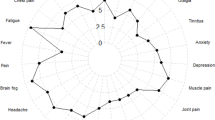Abstract
This cost-of-illness analysis based on information from 2973 patients with multiple sclerosis (MS) in Germany is part of a Europe-wide study on the costs of MS. The objective was to analyze the costs and quality of life (QOL) related to the level of disease severity. Patients from six centres (office- and hospital-based physicians) and patients enrolled in a database were asked to participate in the survey; 38% answered a mail questionnaire. In addition to details on the disease (type of disease, relapses, level of functional disability), the questionnaire asked for information on all resource consumption, medical, non-medical, work absence, informal care, as well as QOL (measured as utility). The mean age of the cohort was 45 years, and 18% of patients were 65 years of age or older. Forty-seven percent of patients had mild disease (Expanded Disability Status Scale [EDSS] score 0–3), 36% had moderate disease (EDSS score 4–6.5) and 12% had severe disease (EDSS score ≥7). The mean EDSS score in the sample was 3.8 (median 4.0), with a mean utility of 0.62. Costs and utility are highly correlated with disease severity. Workforce participation decreases from 73% in very early disease to less than 10% in the very late stages, leading to a tenfold rise in productivity losses in the late stages of disease. Hospitalisation and ambulatory visits rise by a factor of 5–6 between early and late disease; investments and services increase from basically no cost to € 2700; and informal care increases by a factor of 27 for patients with an EDSS score of 7 and by a factor of 50 for patients at the very severe end of the EDSS scale (8–9). Hence, total mean costs per patient are determined essentially by the distribution of the severity levels in the sample, increasing from approximately € 18 500 at an EDSS score of 0–1 to € 70 500 at an EDSS score of 8–9. The same is true for utility, which decreases from 0.86 to 0.10 as the disease becomes severe. However, the utility loss compared to the general population is high at all levels of the disease, leading to an estimated loss of 0.2 quality-adjusted life-years per patient. Relapses are associated with a cost of approximately € 3 000 and a utility loss of 0.1 during the quarter in which they occur. Compared with a similar study performed in 1999, resource consumption, with the exception of drugs, is somewhat lower. This is most likely due to a difference in the severity distribution of the two samples and to changes in health-care consumption overall in the country, such as the introduction of diagnosis-related groups (DRGs, Fallpauschalen).






Similar content being viewed by others
References
Kobelt, G, Berg J, Lindgren P, Jönsson B (2006) Costs and quality of life of multiple sclerosis in Europe. J Neurol Neurosurg Psychiatry. Online publication, May 11 (doi: 10.1136/jnnp.2006.090365)
Rosati G (2001) The prevalence of multiple sclerosis in the world: an update. Neurol Sci 22: 117–139
Pugliatti, M, Sotgiu S, Rosati G (2002) The worldwide prevalence of multiple sclerosis. Clin Neurol Neurosurg 202: 82–191
Pugliatti, M, Rosati R, Carlton H et al. (2006) The prevalence and incidence of multiple sclerosis in Europe. Eur J Neurol 13: 1–23
Hein T, Hopfenmuller W (2000) Hochrechnung der Zahl an Multiple Sklerose erkrankten Patienten in Deutschland. Nervenarzt 71: 288–294
Kobelt, G, Lindgren P, Smala A, Jönsson B, Group Gms (2001) Costs and quality of life in multiple sclerosis. A cross-sectional observational study in Germany. Eur J Health Econ 2: 60–68
Poser S (1994) The epidemiology of multiple sclerosis in southern Lower Saxony. In: Firnhaber W, Lauer K (eds) Multiple sclerosis in Europe: an epidemiological update. Darmstadt, Germany: Leuchtturm-Verlag/LTV Press
Kurtzke J (1983) Rating neurological impairment in multiple sclerosis and expanded disability status scale (EDSS). Neurology 33: 1444–1452
The EuroQol Group (1990) EuroQol – a new facility for the measurement of health-related quality of life. Health Policy 16: 199–208
Dolan P (1995) A social tariff for EuroQol: results from a UK general population survey. Centre for Health Economics, University of York: York
Kobelt G, Lindgren P, Parkin D, Jönsson B (2000) Costs and quality of life in multiple sclerosis. A cross-sectional observational study in the United Kingdom. SEE/EFI Working Paper Series in Economics and Finance No. 399. Stockholm School of Economics; Stockholm, Sweden
Eichler H, Kong SX, William C, Gerth, PM, Jönsson B (2004) Use of cost-effectiveness analysis in health-care resource allocation decision-making: how are cost-effectiveness thresholds expected to emerge? Value in Health 7: 518–528
Acknowledgement
K. Berger (Medical Economics Research Group, Munich); O. Ström (Stockhkolm Health Economics, Sweden)
Conflict of interest
No information supplied.
Author information
Authors and Affiliations
Corresponding author
Rights and permissions
About this article
Cite this article
Kobelt, G., Berg, J., Lindgren , P. et al. Costs and quality of life of multiple sclerosis in Germany. Eur J Health Econ 7 (Suppl 2), 34–44 (2006). https://doi.org/10.1007/s10198-006-0384-8
Issue Date:
DOI: https://doi.org/10.1007/s10198-006-0384-8




